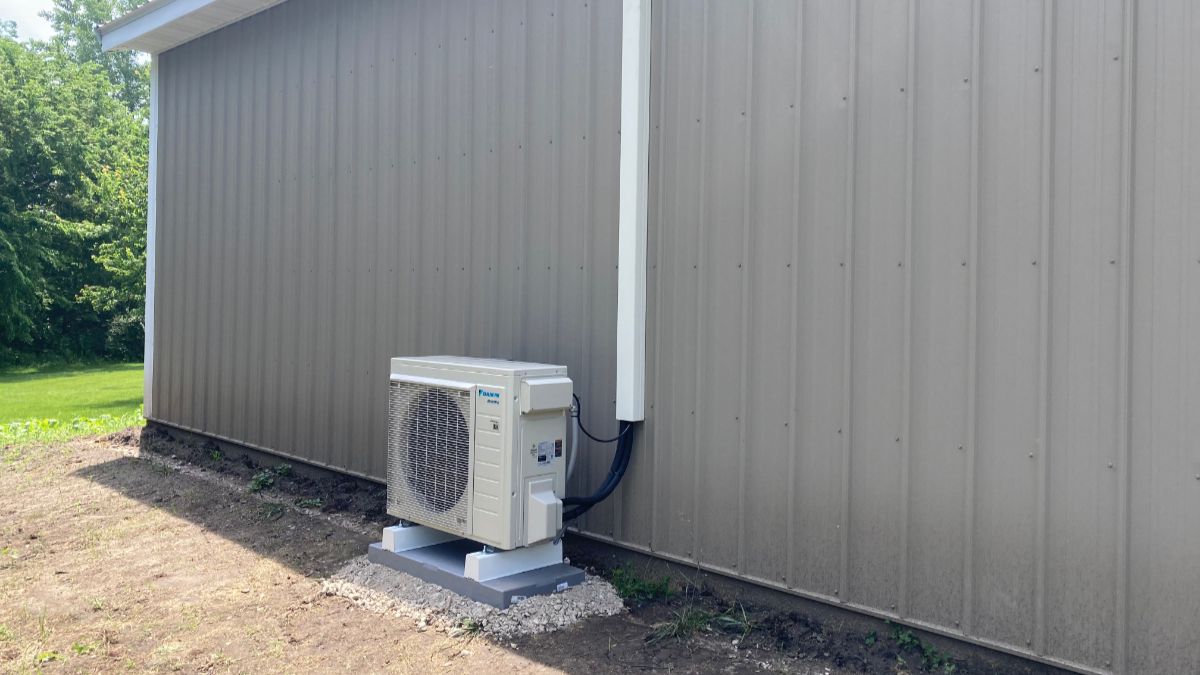
- September 25, 2025
- admin
- 0
Utility bills aren’t getting cheaper. And if you live in Iowa, you know your HVAC system gets a workout — cooling through sticky summers and heating through bitter winters.
Even with central air, many homeowners find themselves paying more than they should.
Here’s the good news: a mini split system can help.
Not by replacing your central air, but by working alongside it to reduce waste, boost efficiency, and bring comfort exactly where you need it.
What Is a Mini Split System?
A mini split is a ductless heating and cooling system. It connects an outdoor compressor to indoor air handlers through a small wall opening (about 3 inches wide). Each indoor unit can be set to its own temperature, giving you “zoned” comfort.
Unlike central air, which conditions the whole home through ducts, mini splits focus on specific rooms or zones. Think of them as a precision tool—not a replacement, but a smart partner for your existing HVAC.
Curious how the installation works? See our Mini Split Installation Service guide.
Why Central Air Alone May Not Be Enough
Central air is reliable, but it’s not perfect.
-
Ductwork loses 20–30% of energy as air leaks or dissipates through walls and attics, according to Energy.gov.
-
One thermostat rules the house, which means upstairs rooms often overheat while basements stay chilly.
-
Larger systems work harder, running longer cycles that drive up bills.
This is where mini splits step in—covering the gaps and lowering your energy use.
How a Mini Split Can Lower Your Energy Bills
Adding a mini split to your home can cut energy waste in several ways:
-
Zoned comfort: Only heat or cool the rooms you actually use.
-
No duct losses: Energy goes straight into your living space, not the attic.
-
Variable speed (inverter) technology: Mini splits don’t blast on/off like central air. They run continuously at low power, using less energy overall.
Ductless systems can reduce energy use by 30% or more, especially in homes with inefficient ducts.
Strategic Uses of Mini Splits in Homes with Central Air
So, where does a mini split make the most difference?
Hot upstairs bedrooms – Keep them cool without blasting AC for the whole house.
Finished basements – Condition the space without pulling energy from upstairs ducts.
Home offices – Heat or cool only the room you’re working in during the day.
Garages or workshops – Add comfort without extending ductwork.
Want ideas for placement? See our blog on Best Rooms for Mini Split Installation.
Cost vs. Savings: The ROI of Adding a Mini Split
Yes, mini splits come with upfront costs.
-
Installation cost: $3,000–$7,000 per zone.
-
Rebates & incentives: ENERGY STAR models often qualify for rebates and tax credits.
-
Savings potential: Lower bills + less wear on your central air = savings every month.
ENERGY STAR reports that ductless systems can use up to 60% less energy than baseboard heaters and significantly less than traditional AC. For many families, that translates into $500–$800 per year in savings.
Maintenance and Longevity
Mini splits aren’t just efficient—they’re built to last.
-
Mini splits: Lifespan of 15–20 years. Simple DIY filter cleaning every 1–3 months, plus an annual checkup.
-
Central air: Lifespan of 12–15 years. Needs duct cleaning, frequent filter changes, and regular service.
Pairing both systems reduces strain on each, extending their lifespans.
Ask about our maintenance plans when you call.
The Iowa Advantage
Mini splits aren’t just for mild climates.
-
Summer: Handle high humidity efficiently without overcooling the entire house.
-
Winter: Cold-climate models run effectively down to -13°F, covering most Iowa winters.
-
Year-round: When paired with central air, mini splits help balance comfort and keep energy bills predictable.
Frequently Asked Questions About Mini Splits and Energy Saving
Do mini splits lower your electric bill?
Yes. By avoiding duct losses and conditioning only the rooms you use, mini splits can reduce monthly bills by up to 30%.
Is it cheaper to run a mini split or central AC?
Often, yes—especially if your ducts are old or leaky. Mini splits have higher SEER ratings (20+) compared to central AC (15–18).
How much does a mini split cost to run per day?
Most use $1–$2 of electricity per day, depending on usage, compared to $3–$5 for central AC.
What are the downsides of mini splits?
They have a higher upfront cost and require wall or ceiling space for indoor units. Aesthetics can also be a concern for some homeowners.
Will adding a mini split reduce wear on my central air?
Yes. By shouldering the load in problem rooms, mini splits keep central systems from running longer cycles, extending their lifespan.
Conclusion: Smarter Comfort, Lower Bills
A mini split isn’t just a backup—it’s a strategic way to make your central air more efficient. By targeting problem rooms, reducing duct losses, and lowering strain on your system it helps you stay comfortable while cutting costs.
Ready to make the call? Contact Anthem Heating & Cooling today at 515-249-2581 (Bondurant) or 641-485-1998 (Grinnell). We proudly serve Bondurant, Grinnell, Ankeny, and across Central Iowa.
